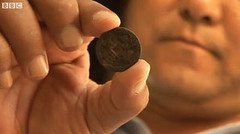
PREV ARTICLE
NEXT ARTICLE
FULL ISSUE
PREV FULL ISSUE
COULD A RUSTY COIN RE-WRITE CHINESE-AFRICAN HISTORY?
Dick Hanscom forwarded this article from the BBC News service from Africa about an archeological team from China and their findings, which include coins.
-Editor
A joint team of Kenyan and Chinese archaeologists found the 15th Century Chinese coin in Mambrui - a tiny, nondescript village just north of Malindi on Kenya's north coast. In barely distinguishable relief, the team leader Professor Qin Dashu from Peking University's archaeology department, read out the inscription: "Yongle Tongbao" - the name of the reign that minted the coin some time between 1403 and 1424. "These coins were carried only by envoys of the emperor, Chengzu," Prof Qin said. "We know that smugglers would often take them and melt them down to make other brass implements, but it is more likely that this came here with someone who gave it as a gift from the emperor." And that poses the question that has excited both historians and politicians: How did a coin from the early 1400s get to East Africa, almost 100 years before the first Europeans reached the region? The answer seems to be with Zheng He, also known as Cheng Ho - a legendary Chinese admiral who, the stories say, led a vast fleet of between 200 and 300 ships across the Indian Ocean in 1418. Until recently, there have only been folk tales and insubstantial hints at how far Zheng He might have sailed. Then, a few years ago, fishermen off the northern Kenyan port town of Lamu hauled up 15th Century Chinese vases in their nets, and the Chinese authorities ran DNA tests on a number of villagers who claimed Chinese ancestry. The tests seemed to confirm what the villagers have always believed - that a ship from Zheng He's fleet sank in a storm and the surviving crew married locals, meaning some people in the area still have subtly Chinese features. It was then that Peking University organized its expedition to try to find conclusive evidence. The university is spending $3 million (£2 million) on the three-year project. While the evidence is still not conclusive, it undermines Portuguese explorer Vasco Da Gama's claim to have been the first international trader to open up East Africa. He arrived in 1499 on an expedition to find a sea route to Asia, and launched more than 450 years of colonial domination by European maritime powers. To read the complete article, see: Could a rusty coin re-write Chinese-African history? (www.bbc.co.uk/news/world-africa-11531398) Via Facebook, Martin Purdy adds: The only problem with this theory is that I believe the "Yongle tongbao" coins were all made retrospectively, i.e. none were actually produced during the 1403-24 period covered by the reign title. I'd need to re-check the details but I understood they were produced at a later date to "fill the gap" at the request of a subsequent emperor, and then became an incredibly popular coin that was imitated throughout Asia and as far away as Java. I picked up numerous examples in Japan in the 1980s, one of which was attributed to Java because of its metal content. Traders may well have taken them to East Africa, but I suspect it would have been well after the 15th century, and probably not Chinese traders either, given the ban on ocean-going vessels in later years. Wayne Homren, Editor The Numismatic Bibliomania Society is a non-profit organization promoting numismatic literature. See our web site at coinbooks.org. To submit items for publication in The E-Sylum, write to the Editor at this address: whomren@gmail.com To subscribe go to: https://my.binhost.com/lists/listinfo/esylum All Rights Reserved. NBS Home Page Contact the NBS webmaster 
|
